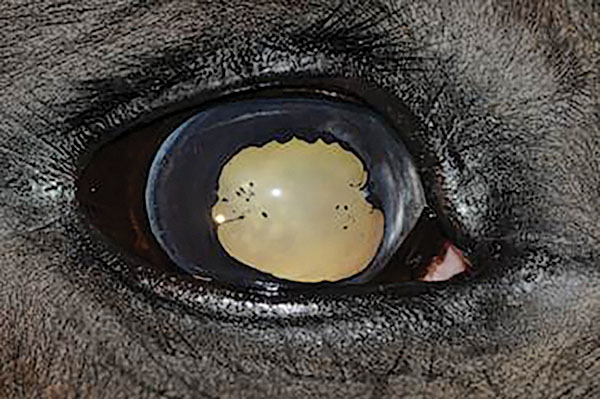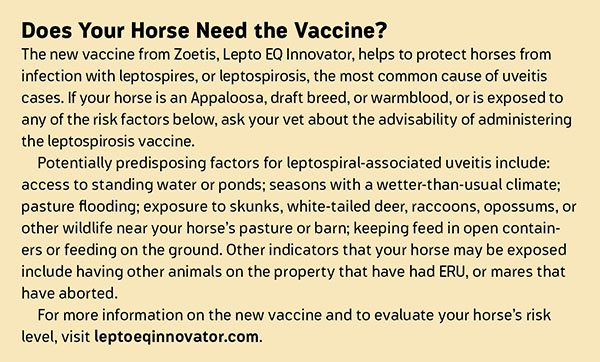Uveitis is a painful inflammation of the eye with potentially career- or even life-ending complications. We asked Dr. Jacquelin Boggs, senior veterinarian with Zoetis Equine Technical Services, to explain what you need to know now about this disease.

What causes uveitis?
In horses, uveitis can be caused by trauma to the eye, corneal disease (such as ulcers), and bacterial or fungal infections of which leptospirosis is the most common cause. Uveitis can affect one or both eyes. You may notice an affected eye appearing cloudy or discolored. Your horse may squint or tear excessively, and the pupil may be constricted. These are frequently the first signs, with more severe changes to the eye developing with subsequent flare-ups. Even with the best treatment, most horses that develop recurrent uveitis won’t return to their previous level of performance. That means prevention is key.
Is equine recurrent uveitis (ERU) different from uveitis?
ERU, also known as moon blindness, occurs repeatedly over the life of the horse. The flares can be spread months or even years apart; however, the interval between flares often shortens over the horse’s lifetime. With ERU, the horse’s body incorrectly attacks normal or host proteins, causing damage that can lead to blindness. ERU is the most common cause of blindness in horses worldwide.
And leptospirosis is a major trigger?
ERU is a disease with many involved factors. Genetics, auto-immune responses, and an initial trigger all play roles. While there are many potential triggers, research to date indicates the number-one trigger is leptospiral organisms, representing 70 percent of ERU cases.
What types of horses are at greatest risk?
All breeds of horses are susceptible to ERU. There is a genetic component to this disease, however, and studies indicate that some breeds—including the Appaloosa plus draft and warmblood breeds—are genetically more prone to ERU. Unfortunately for Appaloosas, not only are they at an increased risk of developing uveitis, but they also tend to lose their sight faster than do other horses and have a higher risk of going blind in both eyes.
What can I do to prevent uveitis, and what treatments are available?
Until now, preventive options have been limited, but last fall Zoetis introduced the first and only approved equine leptospirosis vaccine for the prevention of disease in healthy horses (see box). Unfortunately, once a horse has clinical signs of uveitis, the only option is treating those symptoms, which is challenging. There is no cure for ERU. Your veterinarian can work to control an active uveitis episode using topical corticosteroids, atropine, and systemic nonsteroidal medications. With each episode of uveitis, however, more damage to the eye is done, and prevention of these recurring episodes is nearly impossible once the inflammatory process has been initiated. Cyclosporine implants and vitrectomy (removal of the vitreous sac) are more sophisticated procedures with higher expenses and variable outcomes.







